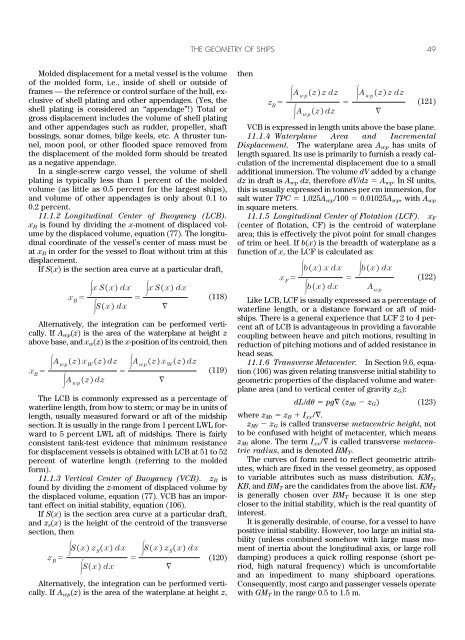The Geometry of Ships
You also want an ePaper? Increase the reach of your titles
YUMPU automatically turns print PDFs into web optimized ePapers that Google loves.
48 THE PRINCIPLES OF NAVAL ARCHITECTURE SERIES<br />
eficial in this respect (Fig. 27). A longitudinal (body plan)<br />
view gives good indications <strong>of</strong> the quantity and quality <strong>of</strong><br />
data, whether or not appendages were included, etc., but<br />
<strong>of</strong> course lacks the crucial information <strong>of</strong> where each station<br />
was located. An oblique perspective or orthographic<br />
view is a good supplement to the body plan.<br />
11.1 Curves <strong>of</strong> Form. For a vessel that operates at a<br />
significant range <strong>of</strong> loadings (displacements), the hydrostatic<br />
properties must be presented for a range <strong>of</strong><br />
flotation conditions. It is customary to use vessel draft<br />
as the independent variable, and to tabulate properties<br />
at a reasonable number <strong>of</strong> draft values. This information<br />
is presented graphically in the curves <strong>of</strong> form drawing<br />
(Fig. 36). In the curves <strong>of</strong> form, the draft is the vertical<br />
axis (presumably, because draft is a vertical measurement),<br />
and dependent quantities are plotted horizontally.<br />
<strong>The</strong> plot is complicated by the fact that the various<br />
hydrostatic quantities have different units and widely<br />
varying magnitudes. <strong>The</strong>refore, a generic “scale <strong>of</strong><br />
units” from 0 to 10 is used, and quantities are scaled by<br />
powers <strong>of</strong> 10 (and sometimes other factors) to fit on the<br />
plot. <strong>The</strong> scaling factors and units for each curve must<br />
be supplied in the legends or keys. <strong>The</strong> range <strong>of</strong> draft<br />
should go from somewhat below the minimum working<br />
displacement to somewhat above the deepest loading<br />
expected.<br />
Curves <strong>of</strong> form present information primarily relevant<br />
to zero-trim conditions. Hydrostatic quantities that are<br />
expected in the curves <strong>of</strong> form include:<br />
• Displacement (fresh and salt water)<br />
• Longitudinal center <strong>of</strong> buoyancy<br />
• Vertical center <strong>of</strong> buoyancy<br />
• Waterplane area (displacement per unit immersion)<br />
• Longitudinal center <strong>of</strong> flotation<br />
• Transverse metacentric height (above keel)<br />
• Longitudinal metacentric height (above keel).<br />
Other quantities sometimes presented in curves <strong>of</strong><br />
form are:<br />
• Wetted surface<br />
• Form coefficients, e.g., block and prismatic<br />
coefficients.<br />
11.1.1 Displacement. Volume displacement is<br />
the volume <strong>of</strong> the vessel below the plane <strong>of</strong> flotation.<br />
Displacement is the weight <strong>of</strong> displaced fluid, i.e., g.<br />
In SI units, displacement is given in metric tons, or kilograms<br />
for small craft. Curves <strong>of</strong> form usually include<br />
three displacement curves:<br />
• Molded displacement in salt water<br />
• Total (gross) displacement in fresh water<br />
• Total (gross) displacement in salt water.<br />
Fig. 36 Curves <strong>of</strong> form for the ship <strong>of</strong> Fig. 32.



